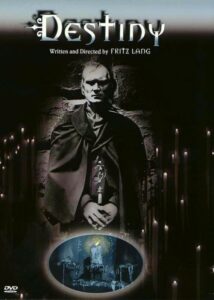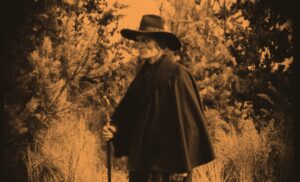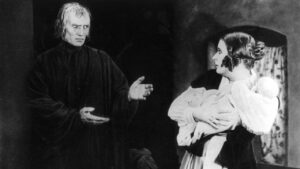“Destiny” by Fritz Lang – Tanatos with a Human Face

Title: “Destiny” (“Der müde Tod”)
Release Date: 1921
Director: Fritz Lang
Cast: Lil Dagover, Bernhard Goetzke, Walter Janssen, Karl Platen, Georg John, Hans Sternberg
Fritz Lang has created a poignant yet beautiful image of the Angel of Doom in “Destiny”. His ambivalent portrayal balances between an awe-inspiring fate and a merciful Samaritan who can heal all human wounds.
“Destiny” is a 1921 silent film by Fritz Lang. The work is one of the most important achievements of German expressionism. It delights the viewer with its richness of poetic means of expression, whether in terms of set design, cinematography, props or plot. “Destiny” still touches the viewer with its deep reflection on human fate, and above all with the construction of the main character. The film’s plot is framed by the story of a girl (played by Lil Dagover) suffering after the loss of her beloved (Walter Janssen). A young woman makes a suicide attempt and goes before the Angel of Death to beg him to spare her fiancé’s life. Unexpectedly, the heroine is given a chance – if she manages to prevent the death of one of the three men who are about to die, the young man will regain his life.
The girl thus impersonates three women in three different space-time realities. The first story takes place in Baghdad in the 9th century, the second in Renaissance Venice, and the last in ancient China. In each story, we are confronted with the theme of love thwarted by heartless social divisions. The heroine fails to save any of the young men. She is given one last chance – she can convince one of the living to voluntarily give their lives for her beloved. But it turns out that even beggars and the terminally ill are very attached to their existence. Ultimately, the heroine dies in a fire, saving an infant from death. Through this act of love, she is able to reunite with her lost lover for eternity.

“Destiny” – Fritz Lang’s poetic masterpiece
“Destiny” is undoubtedly a poetic masterpiece of silent cinema. The set design, as well as the construction of the characters, was inspired by expressionist painting, e.g. in the style of Edvard Munch. Thus, we see characteristic disturbing landscapes, labyrinthine buildings, winding staircases, dark interiors with mysterious play of light. The characters (especially the inhabitants of the German town) have unnatural, grotesquely twisted faces and somehow merge with the background like paper creations.
Gothic literature, especially horror novels, was an important source of inspiration for Fritz Lang. In “Destiny” we find the typical frenetic style created by night, phantoms, and the gloomy contours of city buildings. Above all, the viewer’s imagination is captured by the mysterious Wall of Fate, through which the dead pass, and by the room where human lives are smouldering in the form of candles.
Noteworthy are, of course, the technical solutions that were innovative for those times, such as trick photography or the introduction of fantastic elements to the Chinese story, such as a flying carpet, a magic horse or an army of lilliputians. All these elements create a highly suggestive whole, captivating even the contemporary viewer with its unusual atmosphere.
“Destiny” – Angel of Doom
“Destiny” is, however, first and foremost one of the most poignant allegorical images of the title character in the history of cinema. The phenomenal construction of the Angel of Doom, played by Bernhard Goetzke, almost radiates ambiguity. Even on the visual level, the character is deeply memorable. It is no coincidence that Ingmar Bergman would later allude to this image of fate in “The Seventh Seal”.

We are dealing here with a masterful combination of various cultural motifs of death. In the Arabian story, for example, death appears as the gardener-robber, while in the Chinese story it is the Rider of the Apocalypse. Fritz Lang’s death is truly majestic and awe-inspiring. At the same time, however, Tanatos is here endowed with the attribute of mercy. His eyes reflect a deep compassion for the human condition. Through such anthropomorphization the director builds a higher level of ideological pessimism. Even death is “tired” of its profession, which gives the insignificance of existence the stamp of tragedy.
“Destiny” film: ” For love is as strong as death…”
The story of “Destiny” is built up by references to European myths and beliefs. It reflects the ancient tale of Orpheus and Eurydice, and a kind of leitmotif of the film are the words from the “Song of Songs”: “For love is as strong as death, Jealousy is as severe as Sheol”. Fritz Lang’s movie is a kind of illustration of this truth – only love is a force as powerful as death. Thanks to it, man gains the ability to make the highest sacrifices and can overcome the primal fear of passing into oblivion oblivion.
Literature:
A.Grabicz, Cinema, the magic vehicle. Guide to the achievements of feature film. The First Journey 1913 – 1949, Kraków 2007.
